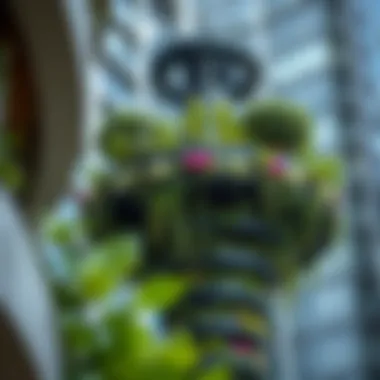Hanging Garden Tower: Innovative Urban Greenery Solutions


Intro
In the midst of urbanization, greenery often takes a back seat, overshadowed by concrete jungles and towering skyscrapers. Yet, cities are beginning to realize the importance of introducing nature into the fabric of their existence. Conventional gardens and parks may not suffice to meet the demands of a burgeoning population. Enter the hanging garden tower. This innovative approach to urban greenery is leapfrogging traditional models and redefining how we look at sustainable agriculture in cityscapes.
The concept is simple yet transformative. Hanging garden towers optimize space while providing fresh produce, improving air quality, and enhancing aesthetic appeal. In places like Dubai, where real estate is thriving, these towers are not just an adornment but a vital part of the urban ecosystem. By delving into the design, functionality, and the myriad advantages they offer, we embark on a journey to understand how hanging garden towers can make a mark in contemporary urban living.
As we explore the intricate relationship between these towers and the urban landscapes, we’ll uncover their environmental benefits, community involvement, and technological advancements that make them feasible. Furthermore, by examining case studies, we aim to illuminate the potential influence of hanging garden towers on the future of real estate and urban planning. Strap in—this exploration promises to be enlightening for real estate agents, investors, buyers, and developers alike.
Foreword to Hanging Garden Towers
Urban development is reaching unprecedented heights, both literally and figuratively. As cities grow, they often lose their connection to nature, leading to a disconnection between urban environments and ecological balance. The Hanging Garden Tower emerges as an innovative solution to this pressing issue, serving not only as an aesthetic addition but also as a functional element that integrates greenery into densely populated areas. This introduction aims to shed light on the significance of hanging garden towers in revitalizing urban landscapes.
Definition and Overview
A Hanging Garden Tower can be defined as a vertical gardening system that allows for the cultivation of plants on building facades or dedicated structures that hang plants vertically, thus maximising space efficiency. These towers often employ various plant species, creating a lush vertical oasis with potential benefits for both the environment and the inhabitants. With the ability to support a mix of ornamental and edible plants, these structures foster a more sustainable approach to urban living. The adoption of such towers is increasingly seen as a necessary tactic in combating urban heat islands, improving air quality, and enhancing biodiversity — truly an oasis in a concrete jungle.
Moreover, hanging garden towers are designed to be self-sustaining, featuring advanced irrigation systems that minimize water usage. This particular aspect can greatly help mitigate the challenges faced by urban agriculture and infuse greenery back into city environments where traditional farming may seem impractical. The adoption of these towers presents a multi-faceted solution to the ongoing urbanization challenge.
Historical Context and Inspiration
The roots of vertical gardens can be traced back to various ancient civilizations. The Hanging Gardens of Babylon, one of the Seven Wonders of the Ancient World, serves as a historical parallel. Although their existence is disputed, the idea of integrating nature into urban architecture has persisted throughout the ages.
In modern times, inspiration has been drawn from the concept of green architecture, which gained momentum in the late 20th century. Architects like Patrick Blanc popularized vertical gardens, showing how greenery could thrive on walls. These implementations sparked a revolutionary dialogue about architecture’s role in environmental stewardship, giving rise to the designs of contemporary hanging garden towers.
"Integration of nature into architecture not only beautifies urban spaces but also addresses environmental challenges head-on."
The exploration of these towers will unfold through their design intricacies, functionality, and the challenges they present. This journey through the urban green revolution is both timely and essential.
The Design of Hanging Garden Towers
The design of hanging garden towers stands as a pivotal aspect of this innovative approach to urban greenery. As cities grow, the need for sustainable solutions becomes increasingly important, and hanging gardens offer a fresh perspective on how we can integrate nature into bustling urban environments. The design incorporates various architectural features, innovative materials, and sophisticated irrigation systems, all aimed at enhancing functionality while addressing sustainability concerns.
Architectural Features
Architecturally, hanging garden towers exhibit unique designs that blend aesthetic appeal with practical function. These structures often feature:
- Vertical farming spaces: Utilizing vertical layers for planting maximizes land usage, enabling city dwellers to grow more food per square foot.
- Cantilevered balconies: These provide additional growing space while also enhancing the visual appeal of the tower.
- Integrated green facades: The use of greenery on building exteriors not only beautifies but also helps insulate buildings, reducing energy consumption.
These features collectively contribute to creating an urban ecosystem where flora and fauna coexist with human activity. Importantly, the design creates engaging spaces for occupants, encouraging interaction with green areas which can break the monotony of concrete and steel.
Material Selection and Sustainability
The selection of materials used in the construction of hanging garden towers is a careful balancing act. Sustainable materials are preferred, reducing the overall carbon footprint. Key considerations include:
- Recycled materials: Using reclaimed wood, metal, or glass helps minimize waste in construction processes. For example, many structures creatively repurpose old shipping containers as part of their framework.
- Lightweight composites: These materials reduce the impact of additional weight on building foundations while maintaining strength. This is crucial for tall structures in urban settings.
- Biodegradable products: Implementing materials that naturally break down over time ensures that the urban landscape can adapt, reducing long-term pollution.
By prioritizing sustainable materials, architects and developers contribute significantly to environmental health while ensuring the longevity of the hanging garden towers.
Innovative Irrigation Systems


Water is the lifeblood of any garden, and hanging garden towers employ advanced irrigation systems to optimize water usage. Critical aspects include:
- Hydroponics and aeroponics: These soil-less methods enhance growth efficiency, allowing plants to absorb nutrients directly from the water. They are particularly beneficial in urban settings where space is limited.
- Rainwater harvesting: Towers often integrate systems to collect and repurpose rainwater, thereby promoting self-sustainability. For instance, many models channel rain runoff from structures to irrigation systems, reducing dependency on city water supplies.
- Smart irrigation technology: This involves sensors that monitor moisture conditions and automate watering schedules, ensuring plants receive just the right amount of water without waste.
Adopting these innovative systems is essential in urban locations, where access to water might be limited or expensive. Additionally, they help mitigate the challenges posed by unpredictable climates.
"The future of urban living lies in our ability to harmonize structures with nature. Hanging garden towers exemplify this relationship, showcasing a design ethos that prioritizes both beauty and sustainability."
As we delve deeper into this topic, it becomes increasingly clear that the design elements of hanging garden towers play a crucial role not just in environmental sustainability but also in enhancing urban living. In a world facing climate challenges, these towers stand as a testament to what thoughtful design can achieve in integrating greenery into our cities.
Functionality and Benefits
The integration of hanging garden towers in urban areas serves multifaceted benefits that extend far beyond mere aesthetics. These towers exemplify how architectural innovation can bridge the gap between urban development and environmental sustainability. Taken together, their functionality enriches urban life in profound ways, contributing significantly to ecological well-being and community engagement. Below are some critical benefits of hanging garden towers:
Enhancing Urban Aesthetics
Hanging garden towers introduce greenery to urban landscapes where throwaway spaces often dominate. They ornament concrete jungles by showcasing vibrant flora in previously unremarkable areas. Imagine walking through a bustling downtown and encountering a vertical garden cascading down a high-rise; such visuals can transform the monotony of glass and steel into a soothing sea of green.
- Color and Texture: The presence of plants introduces not only color but also varying textures, which can reduce the starkness of architectural lines.
- Community Identity: Iconic towers can become landmarks, giving neighborhoods a sense of identity and character.
- Public Space Usage: These structures can enhance public spaces, fostering social interactions as people gather around them, thus elevating the overall experience of the surrounding environment.
Improving Air Quality
One cannot overlook the role of plants in purifying the air. Hanging garden towers can act as urban lungs, improving the quality of life for city dwellers. Through the process of photosynthesis, plants absorb carbon dioxide and release oxygen, contributing to a healthier atmosphere. With the rapid urbanization we observe today, this cannot be understated.
- Pollutant Absorption: Studies have shown that specific plant species can effectively absorb harmful pollutants, such as particulate matter and volatile organic compounds.
- Microclimate Regulation: Vegetation helps regulate temperature, thus mitigating heat island effects prevalent in urban environments.
- Enhanced Well-Being: Cleaner air can contribute to better overall health, lowering risks related to respiratory illnesses and creating a more pleasant living environment.
Local Food Production
Another striking advantage of hanging garden towers lies in their ability to facilitate local food production. This is especially revolutionary in places with limited gardening space. Urban gardening can flourish here, promoting food security and sustainability.
- Access to Fresh Produce: Residents have convenient access to fresh vegetables and herbs, encouraging healthier eating habits.
- Education on Sustainability: These gardens can serve as teaching platforms for sustainable farming practices, potentially becoming educational hubs.
- Reducing Carbon Footprint: Locally grown food minimize transportation emissions, aligning with sustainable practices and reducing the overall carbon footprint associated with food production.
Biodiversity and Habitat Creation
Furthermore, hanging garden towers harbor potential to enhance urban biodiversity. By creating vertical ecosystems, these structures can attract various species and contribute to ecological balance.
- Pollinator Friendly: They can attract pollinators like bees and butterflies, essential for a thriving urban ecosystem.
- Habitat Nurturing: Apart from plants, the use of varied structures can encourage birds and insects to settle, turning sterile high-rise environments into dynamic ecosystems with rich interactions.
- Fostering Environmental Awareness: As communities engage with these structures, awareness about biodiversity and environmental stewardship grows, fostering a stronger connection to nature in urban settings.
"The urban environment is often thought of as a harsh landscape devoid of nature's touch. Hanging garden towers challenge that perspective, marrying design with ecological necessity."
In closing, the functionality of hanging garden towers encompasses aesthetic enhancement, air purification, local food production, and biodiversity support. These structures are not merely ornamental; they are pivotal in shaping future urban landscapes toward a more sustainable and harmonious coexistence with nature.
Challenges and Limitations
Exploring the concept of hanging garden towers means not only celebrating their achievements but also grappling with the challenges they present. Understanding these obstacles is crucial for stakeholders in real estate, urban planning, and city management. It provides a balanced perspective on the potential impact of these innovations on urban landscapes.
Maintenance and Upkeep
When it comes to maintenance, the adage "a stitch in time saves nine" rings especially true for hanging garden towers. Their unique structure and greenery require a dedicated team to ensure everything runs smoothly. Regular upkeep is vital.


- Watering Systems: Unlike traditional gardens, hanging towers might use complex automatic irrigation systems. If these fail, plants can suffer quickly.
- Plant Health: Each type of plant may require specific care. Knowing what makes each species tick is essential. This can complicate maintenance efforts.
- Structural Integrity: Monitoring the structural safety of garden towers over time is paramount. Plants grow heavier. Weather conditions can have their toll too. Performing periodic inspections can help mitigate risks.
Failure to engage in consistent maintenance could spell disaster, not just for the plants but also for the overall architecture, potentially leading to costly repairs or worse, compromising safety.
Cost Considerations
Cost is often a sticking point in the conversations about implementing hanging garden towers. Initial investment can feel like stepping into uncharted territory. Investors must consider these factors:
- Installation Costs: Building a hanging garden tower often requires specialized skills and materials, which can inflate the initial budget.
- Ongoing Expenses: Beyond installation, consider water, nutrients, and utility bills. Maintaining vibrant growth can be pricey.
- Potential ROI: However, it’s essential to weigh these costs against potential returns. Enhanced property value, increased rentals due to aesthetic appeal, and energy savings can tip the scale. An informed understanding of the lifecycle costs can help make the financial layout less daunting.
Building Regulations and Permits
Before embarking on creating a hanging garden tower, navigating the bureaucratic labyrinth of building regulations and permits is crucial. Each locality might impose unique guidelines, which can make the process a bit tangled.
- Zoning Laws: Some areas have strict zoning laws that affect how and where you can build. Understanding these laws can avoid unexpected setbacks.
- Safety Regulations: Towers must meet local safety codes. This includes structural soundness and fire safety measures. Ignoring these can lead to hefty fines.
- Environmental Impact Assessments: In regions where sustainability is a priority, conducting assessments may be mandatory before commencing construction.
In summary, while hanging garden towers hold the promise of a greener urban landscape, they aren't free from challenges and limitations. Understanding the complexities around maintenance, cost, and regulations is necessary for all parties involved, be it real estate developers or municipal leaders. Addressing these issues proactively can pave the way for successful implementations, maximizing both environmental and aesthetic rewards.
Case Studies in Dubai and Beyond
The exploration of case studies regarding hanging garden towers highlights their potential and implementation in urban settings, particularly in a rapidly developing city like Dubai. These real-world examples showcase a blend of architectural elegance and environmental consciousness, making them significant not only for their aesthetic value but also for the practical benefits they offer the urban landscape. Each project serves as a testament to innovative thinking, demonstrating how greenery can seamlessly integrate into concrete jungles. One cannot overlook the cultural context of Dubai as it influences these projects, driven by a desire for luxurious living while maintaining a commitment to sustainability.
Prominent Projects in Dubai
Dubai stands at the forefront of modern architecture, where groundbreaking projects redefine urban spaces. One notable example is the Burj Khalifa, which, although primarily known as a skyscraper, incorporates vertical gardens in its design, contributing to the city’s greenery. This iconic tower demonstrates how high-rise buildings can feature low-maintenance plant life, providing aesthetic appeal and promoting biodiversity.
Another considerable project is the Dubai Creek Tower, expected to include hanging gardens that elevate its eco-friendly approach. This structure aims not just to dominate the skyline but also to blend harmoniously with nature, showcasing how ambitious urban developments can prioritize environmental integration.
Additionally, the Green Planet in CityWalk offers an immersive experience surrounding a biodome, emphasizing the importance of vertical greenery and education about biodiversity. These projects reveal how urban greenery can improve quality of life, inviting not only residents but tourists to appreciate the city’s commitment to fostering a greener environment.
International Comparisons
Looking beyond Dubai, one can draw parallels with cities such as Singapore, renowned for its Green Plan. The Gardens by the Bay is a prime example of integrating nature within a bustling city. This park showcases Supertree structures, which house various plant species and serve ecological functions like rainwater collection and energy generation. Singapore’s efforts underline the importance of public spaces that encourage environmental awareness and community engagement, a lesson that Dubai and other urban areas can learn from.
In contrast, Barcelona has embraced the concept of urban farms atop rooftops, which not only provides food security but also promotes community cohesion. The way these cities prioritize hanging gardens reveals differing degrees of cultural acceptance and structural adaptability. Barcelona's model encourages collaboration among residents, transforming rooftops into spaces for food production and social activities, unlike Dubai, where luxury and opulence often direct urban planning.
Overall, case studies from Dubai and comparable cities provide invaluable insight into the concept and execution of hanging garden towers. These examples underscore the assorted benefits, from enhancing urban aesthetics and air quality to promoting biodiversity. Each city’s approach also highlights various challenges such as funding models, community perceptions, and regulatory hurdles, all critical for stakeholders to consider when advocating for this green initiative.
"The integration of nature within cities is no longer a luxury but a necessity for the well-being of urban populations."
Moreover, as urban centers continue to evolve, understanding these diverse approaches will be crucial for real estate agents, developers, and investors alike, as they navigate the unique landscapes shaped by these innovative designs.
Community Engagement and Impact
Urban living often creates a disconnect between residents and nature, but hanging garden towers can serve as bridges, uniting communities with their environment. This synergy is fundamental for generating not just green spaces but also social connections, education, and awareness about sustainability. The relevance of assessing community engagement and impact when discussing hanging garden towers cannot be overstated; it draws attention to how these structures can invigorate urban life and foster a sense of ownership and pride among residents.
Public Perception and Acceptance
The success of hanging garden towers in any community hinges significantly on public acceptance. Should the community embrace this innovative concept, the potential for creating an inviting, green atmosphere is immense. A well-integrated hanging garden tower can yield a myriad of positive perceptions, from aesthetic appreciation to profound environmental benefits. Yet, negative perceptions can arise too. Factors such as skepticism about maintenance costs or concerns regarding the architecture's safety in extreme weather conditions can lead to hesitation.


Community workshops and focus groups often serve as effective platforms for discussion. In cities like Dubai, where skyscrapers dominate the skyline, engaging stakeholders—be it residents, local businesses, or governmental agencies—can address concerns directly. Seeking input allows architects and developers to tailor designs around community needs. Feedback can steer the direction of future projects, ensuring that they are as much a part of the community's identity as its historical landmarks.
"When community members feel heard in the decision-making process, their acceptance of new initiatives increases exponentially."
Educational Opportunities
Hanging garden towers present unique educational opportunities that extend beyond ecological understanding. Schools, universities, and local organizations can utilize these structures as living classrooms. Regular workshops can be organized to teach students about sustainable practices, plant biology, and the effects of urban greenery on the local ecosystem. This hands-on approach not only fosters environmental literacy but also nurtures a generation of eco-conscious citizens.
Moreover, interactive sessions can bring in experts, allowing community members to gain insights into urban agriculture, vertical gardening, and the technology behind innovative irrigation systems used in these towers. Here’s a rundown of educational aspects worth capitalizing on:
- Workshops: Regular gardening sessions, soil management, and sustainable practices can engage community interest.
- Collaborative Projects: Partnerships with schools and universities for research initiatives can spur innovation in urban gardening methods.
- Outreach Programs: Community-led initiatives that encourage younger generations to understand their role in environmental stewardship.
In summary, the inclusion of hanging garden towers in urban spaces not only transforms aesthetics but also weaves community bonds through engagement and education. As real estate agents, investors, and developers contemplate the future of urban living, they must recognize the influence of community interaction in enhancing the viability of such projects.
Future of Hanging Garden Towers
As we look ahead, the potential for hanging garden towers has become increasingly pertinent. Urban environments are grappling with a myriad of challenges, including rapid population growth, rising air pollution levels, and diminishing green spaces. This is where hanging garden towers step in as pivotal solutions, enriching cityscapes and enhancing sustainable practices.
Technological Innovations
One of the most significant factors driving the future of hanging garden towers is the infusion of technology. With advancements in smart agriculture, these towers can be equipped with sensors that monitor plant health, soil moisture, and nutrient levels. Technology such as Internet of Things (IoT) applications can streamline the management of these towers. By using remote monitoring, urban farmers can ensure optimal growth conditions with minimal manual intervention. For example, a smart irrigation system could be set up to give precise amounts of water based on real-time data, rather than relying on a time-based schedule.
Furthermore, it isn't just about nurturing plants; it's about informing the urban ecosystem. Vertical farming technology, allowing for soil-less growth methods such as hydroponics and aeroponics, can transform how we approach urban agriculture. This means food can be grown vertically, even in high-rise buildings, tapping into rooftop spaces or balconies. Undeniably, these innovations could be game changers, providing efficient solutions to food scarcity in cities while reducing carbon footprints.
Scalability and Adaptability
Scalability is another key component to consider in the future of these garden towers. As cities continue to evolve, the design of hanging garden towers must allow for flexible installations. From single units standing independently on rooftops to massive complexes incorporated into lifestyle centers, the approach can diversify based on urban needs. Developers and architects can collaborate to integrate these towers into various architectural styles and environments, ensuring they complement existing aesthetics while serving practical purposes.
Adaptability goes hand in hand with scalability. For locations facing specific climatic stresses, such as high heat or humidity, modifications can be made to support various plant species and cultivation methods. This flexibility positions hanging garden towers not merely as static installations but as dynamic components within the urban fabric, engaging residents and visitors alike. The ongoing dialogue between technology, design, and community will inform how effectively these gardens can contribute to urban landscapes.
"The future is not something we enter. The future is something we create." — Leonard I. Sweet
The further down the road we look, the clearer the benefits become. The integration of hanging garden towers into urban planning isn't just a matter of growing plants; it's about fostering communities, enhancing quality of life, and promoting sustainability. In cities like Dubai, where space is at a premium, these towers can lead a greener renaissance, transforming concrete jungles into verdant oases.
End and Recommendations
In pondering the role of hanging garden towers in urban landscapes, this article has shed light on their multifaceted benefits and challenges. The conclusion not only crystallizes the insights shared but also emphasizes how essential these structures can be for city planners, real estate developers, and policy-makers alike. They offer a way for urban areas to address pressing environmental issues while serving as impressive architectural elements that draw positive attention.
Summarizing Key Insights
From our exploration, it’s clear that hanging garden towers present a solution to various urban dilemmas. Here are the vital points distilled from our findings:
- Environmental Impact: These towers improve air quality through natural filtration, mitigate urban heat islands, and enhance overall biodiversity.
- Local Food Production: Urban gardens can significantly contribute to food security, particularly in densely populated areas like Dubai, where fresh produce can be prohibitively expensive.
- Civic Engagement: Involving the community in the design and maintenance of these gardens fosters ownership and pride among residents.
- Innovative Design and Functionality: The unique architecture of hanging garden towers not only enhances the urban aesthetic but also promotes a new wave of sustainable living.
“Integrating green structures like hanging garden towers is not merely a luxury; it’s a pressing necessity for sustainable urban growth.”
This summary serves as a reminder that the implementation of hanging garden towers can positively transform cities and the lives of those who inhabit them.
Encouraging Sustainable Practices in Urban Design
As we move forward, the focus should be on encouraging sustainable practices in urban design. Here are some strategies that stakeholders can employ:
- Integration with Urban Planning: City planners should weave hanging gardens into broader urban designs, ensuring they complement existing infrastructure rather than merely attaching themselves as afterthoughts.
- Community Participation: Involving the public from the onset in discussions about development can lead to more tailored and acceptable designs that meet local needs.
- Investment in Education: Teaching both residents and developers about the benefits of these structures can spark interest and investment in green technologies.
- Policy Advocacy: Engaging with local governments to promote incentives for sustainable building practices can lead to a more robust implementation of hanging gardens.
It is vital that all involved recognize the unique opportunity that hanging garden towers present. They are not just a trend but can be pivotal in fostering a symbiotic relationship between urban living and nature. By adopting actionable recommendations and integrating innovative practices, we can catalyze a shift towards more sustainable urban environments.











